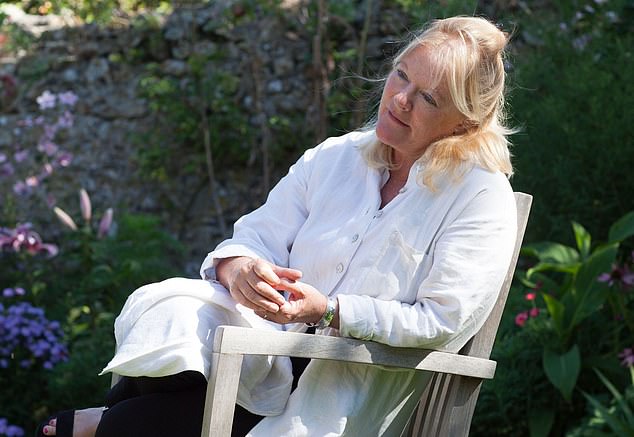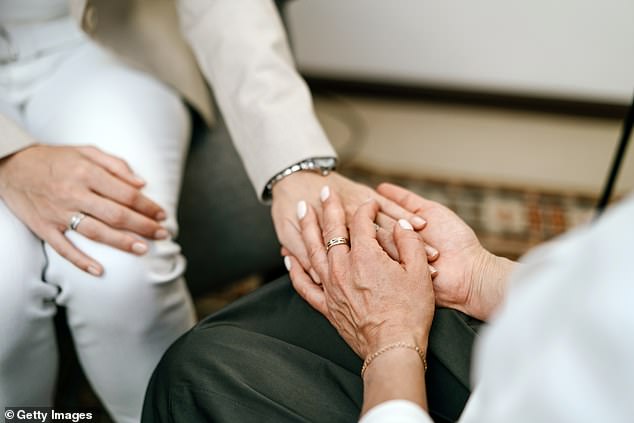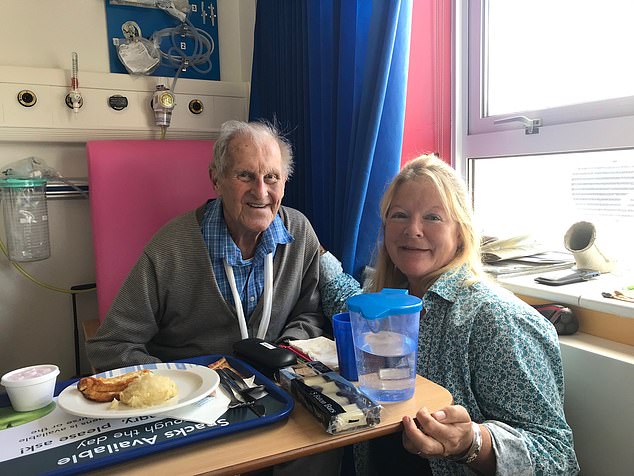In my job, I have helped hundreds of people as they lay dying. For 25 years, I have been a Soul Midwife, also known as a death doula. Just as doulas help guide life into this world, we help guide it out with love and compassion.
This involves helping the dying person practically and physically, as well as spiritually and emotionally.
I have immersed myself in the mystery of what happens when we die, and helped pioneer a movement that today studies and teaches what it means to have a ‘good death’.
So, what is a ‘good death’? And how are Soul Midwives changing what can be an overly-clinical and institutionalised experience and instead, by accepting the possibility of unusual and even supernatural phenomena, soothing people’s fears, easing their transition and helping them die well?
When I started out as a Soul Midwife (having previously been a health journalist), there was a fair amount of scepticism. It was seen as peripheral to the medical establishment and perhaps a little ‘woo woo’.
Today, there are over 1,000 trained Soul Midwives in the UK, many of whom have salaried roles working alongside doctors and nurses in hospitals, hospices and care homes.
And there has never been more need for Soul Midwives. Every year a fifth of NHS spending is on end-of-life care and a third of people in hospital beds are in the final year of their lives.
Yesterday, in the first extract from my book, I described what happens when we die, both physically and spiritually, and some of the ways in which Soul Midwives help souls cross that threshold in peace.

Today, there are over 1,000 trained Soul Midwives in the UK, many of whom have salaried roles working alongside doctors and nurses in hospitals, hospices and care homes

Felicity Warner is a Soul Midwife, someone who offers love, compassion and practical help in the final weeks, days and minutes of someone’s life
Today, I will detail the lessons I have learned about death, and more ways in which Soul Midwives help people cross that threshold – many of which you can implement yourself to help a dying loved one have a ‘good death’.
THEY CAN HEAR YOU
Hearing is the final sense we lose. Even if someone appears to be deeply asleep, sedated, unconscious or in a coma, they can probably still hear you and understand what you say.
Always speak kindly and softly and tell them what you are doing or who is coming to visit them. If you have to leave the room, let them know that you are leaving, and why.
It’s also important to use their own name, rather than ‘Mr’ or ‘Mrs’, ‘Nan’ or ‘Uncle’. Hearing your own name spoken to you can be very intimate and brings a sense of belonging.
Many people who are drifting in and out of life are soothed by the sounds of nature. Audio tracks with the sounds of the sea, birdsong, bees on a summer’s day or streams and rivers are gentle on the ear and can block out the busy sounds of the outside world.
Reading poems to the dying, or playing music, can be an excellent way to help someone release pent-up feelings such as grief, fear, anxiety and sadness. When these emotions are released, positive ones can take their place and huge shifts happen.
Some hospitals and hospices are providing music at the very end of life, with Soul Midwives playing harps, flutes and cellos. The aim is to create a sanctuary where the dying person can enter a deep state of relaxation.
PRE-ACTIVE DYING PHASE
It’s important to help people prepare for death. Often Soul Midwives work with people from the point of diagnosis, when they are still feeling quite well but know they have an illness that will shorten their life.
We call this the ‘pre-active dying phase’ and, for many people, a good death means getting affairs in order during this time.
I once worked with a woman in her 40s who was dying from breast cancer. She was calm and accepted that she wasn’t going to recover. She was a very organised person who had made a list of things to be completed before she went, including writing letters to her children telling them about their childhood illnesses, when they’d first walked and what jabs they’d had, as she knew her husband wouldn’t remember.
She then asked for help in framing some pictures she’d painted in her last months to give as goodbye presents to her godchildren.
Finally, she directed me, from her bed, as I sorted out her wardrobe. I filled several sacks with clothes for the charity shop while she sat up in bed giving me thumbs-up signs for ‘keep it’ and thumbs down for ‘chuck it out’.
We worked through everything on her list and when it was all done, she went to sleep. She died a week or so later, calm in the knowledge that all her affairs were in order.
WELCOME ANCESTORS INTO THE ROOM
Towards the end, many people experience visits from departed loved ones. I have sat in rooms as people on the edge of death appear to greet their ancestors with joy and even hold lengthy conversations with them.
Whether you believe these are real or hallucinations, in my experience, they provide great comfort to those in their final moments.
When someone about to die tells me they hope particular ancestors will help, perhaps parents or grandparents, I call them by name, inviting them into the room and the bedside.
I place a symbol of them (this could be a photograph or a piece of jewellery that belonged to them) on a table nearby and I ask for their help, love and guidance in gratitude.
MAKING AMENDS
As death approaches, Soul Midwives often find a person confides in them about their past and asks for forgiveness.

There is no right or wrong way to create impactful ceremonies, as long as the intention is rooted in love and compassion, says Felicity
I have sat at the bedsides of people who have told me tales of selfishness, anger, unresolved relationships and family dramas, and how much they regret their own actions or wish they had forgiven someone else for theirs.
At this point they may well wish to see someone to make amends with them while they still can. If it is not possible to get that person to the bedside, I offer to help them record a message which I can send on for them.
Simple bedside end-of-life ceremonies can also help a person release anxiety. Sacred blessings and prayers, letting-go rituals for unresolved issues (such as anger, remorse or sadness) and purification rituals may all help someone prepare for their final journey.
There is no right or wrong way to create impactful ceremonies, as long as the intention is rooted in love and compassion.
Sometimes a Soul Midwife will ask for meaningful objects to create an altar beside the bed, write a personal blessing to facilitate forgiveness or mix an anointing oil using a bowl of water and a few drops of amber or sandalwood essential oil.
Making peace with what’s happened during their lifetime helps to ensure a peaceful end, particularly as, if the dying person still has regrets, their soul can become temporarily trapped on this earth.
TELL THEM HOW MUCH YOU LOVE THEM

Felicity with her father David Mudd, the MP for Falmouth and Camborne, who died on 28 April, 2020
In the room where someone is nearing the end, I like to keep a beautiful bowl filled with slips of paper from friends and family, each containing a loving message like ‘Thanks for how loved you always made me feel’ or ‘Thanks for all those wonderful cakes you made us’.
If they are still awake, the dying person can choose a slip or two if they are in need of comfort, or you can read the messages aloud to them if they appear to be slipping in and out of consciousness. Above all, it’s about presence, not presents – time spent with the dying person is worth so much more than flowers and cards.
CLEANSE THEIR ROOM
Everything that happens in an area becomes imprinted on that space, and this is especially true when dealing with the energies of illness and death.
Space clearing is a simple ceremony to revitalise the energies that have become imprinted over time in the walls, furniture and other objects of a room.
The residue of these energies ripples around the edges of a room and builds up, particularly in corners. This is why a room where illness has lingered can feel heavy.
In hospices and hospitals, where many people have died, you can often sense a heavy blanket in the atmosphere. It dulls the space.
Before someone very ill enters a room, make sure it is well prepared for them. Begin with a thorough cleansing. Soap, water, sunlight and fresh air will help to remove any stagnant energy.
Fling open the windows and doors to get the breeze flowing through. Dust and wipe the furniture and sweep the floor. Make sure everything is neat and tidy. Negative energy loves the chaos of clutter.
If it isn’t possible to do a deep clean because the ill person is already using the room, try sprinkling salt into all four corners (salt is a natural cleanser, attracting and absorbing negative energy). The fragrances of burning sage, incense, scented candles and fresh flowers all have a calming effect.
If the person is in a hospice, bring some things from home to make the room cosier: blankets or shawls in pretty colours, photos of the dying friend’s loved ones and pets, or garden flowers.
Use some essential oils in a diffuser to freshen the air and uplift the energy of a room. Good oils to use include frankincense, to guide the soul home; geranium, to calm and cleanse; lavender, to aid sleep and relaxation; and sandalwood, to help the spirit fly.
When people are dying, their sensitivity to odours can be acute, however, so if someone has a negative reaction, remove the fragrance immediately.
USE COLOUR TO SOOTHE

Soul Midwives often drape coloured silk squares on parts of the body to bring a sense of calm and security during treatments, says Felicity
Colour, like smell, can have a great influence on our moods and emotions. Some colours will soothe, some stimulate, others inspire. The colours we choose when we are working with the dying can have a profound effect.
Soul Midwives often drape coloured silk squares on parts of the body to bring a sense of calm and security during treatments. Or you could bring in cushions or throws in the specific colour you want to use.
Red encourages adrenaline and can be used to stimulate empowerment, positivity and focus in the early active stages of an illness. Orange is an appetite-stimulant, and a friendly and outgoing colour. Yellow, a very cheerful and sociable colour, is useful for alleviating depression.
Green is the colour of balance and harmony and used to help relaxation and connection with nature. Blue is a peaceful, calming and stabilising colour and has been shown to reduce blood pressure and heart rate.
Violet, the highest frequency in the colour spectrum, connects people with a sense of spirituality.
HELP THEM IMAGINE A JOYFUL DESTINATION
Towards the end, as well as seeing and even interacting with beloved ancestors, the dying may talk of seeing dancing lights, colours, pets who have already passed on, or angels and religious figures. At this point they often recognise that they are dying and may even tell you when they are going to die.
However you want to think of these experiences, whether as spiritual and a true reflection of what happens or the product of altered chemicals in the brain, it is undeniable that they are soothing to those on the point of death.
People like to imagine a safe place or room where they will rest after transition – a place filled with healing colours, light and music.
One woman I worked with was a passionate dog-lover, who created a story where all the dogs she had ever loved would be waiting for her in a little house in the middle of the woods. As she was dying, she murmured that her favourite dog, Carl, a scruffy rescue collie, had come to take her home.
A good death is a wonderful thing for everyone involved. By alleviating fear, guilt and trauma, we clear the space for a peaceful passing and, for the living, a grief that is easier to bear.
- Adapted from The Soul Midwives’ Handbook (Revised Edition) by Felicity Warner (HayHouse, £14.99), to be published on Tuesday. © Felicity Warner 2025. To order a copy for £13.49 (offer valid to September 6; UK P&P free on orders over £25) go to: mailshop.co.uk/books or call 020 3176 2937.











